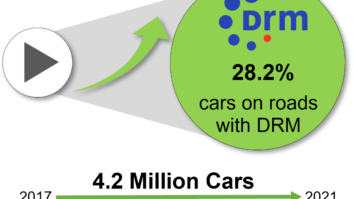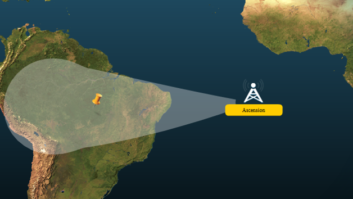By the end of next year, another type of digital radio receiver is expected to make its debut at the consumer level – Digital Radio Mondiale. It is digital radio for shortwave, medium-wave/AM and long-wave.
Several international broadcasters expected to debut live DRM transmissions this month to coincide with the International Telecommunications Union’s World Radiocommunication Conference in Geneva and continue DRM transmissions indefinitely. Some of the broadcasters taking part include Voice of America, DeutschlandRadio, Deutsche Welle, Swedish Radio International, BBC Worldservice, Radio Netherlands, Radio Canada International/CBC and others.
Dr. Don Messer is chief of the spectrum management division of the International Broadcasting Bureau, one of two agencies that oversees U.S. international broadcasters. He said DRM planned to exhibit receivers at the conference with the help of the European Broadcasting Union.
IBB/Voice of America is a U.S. member of DRM, as is the National Association of Shortwave Broadcasters, Harris, Dolby Labs, Continental Electronics, Kintronic Labs, Sangean America and TCI, a Dielectric Co.
At IBC 2002, DRM demo’ed a production-ready world-band consumer receiver made by Coding Technologies together with the BBC and German manufacturer AFG, and a preview version of its first publicly-available receiver, the DRM Software Radio, made by Fraunhofer IIS-A.
VT Merlin Communications is managing the DRM Software Radio Project. The software radios sell for the equivalent of about $70. DRM hopes the software radio will encourage enthusiasts such as DXers to tune into experimental broadcasts. DRM has established a Web page devoted to distribution and support of the DRM Software Radio (www.drmrx.org) .
Consumer DRM radios from Sony are expected to be at retailers by the end of 2004.
With some 600 million to 700 million shortwave receivers in use worldwide, improving the audio quality of shortwave broadcasts was the idea behind DRM, Messer said. Whereas in the United States, one station sends one signal, shortwave broadcasters typically transmit several, hoping one will remain robust and reach its destination.
Long-wave, medium-wave/AM and shortwave are similar in how they have to fight propagation fluctuations compared to FM. For this reason, Messer said, the DRM system has been designed to combat fading, and doppler spread that exists in the long-distance shortwave signals.
Asked if this meant competition with the Eureka-147 DAB technology being used or tested in several European countries and other parts of the world, Messer said no. Eureka requires a much larger bandwidth. DRM is a digital system that uses existing frequencies and bandwidth.
Eureka also is designed so several broadcasters transmit from the same facility at exactly the same power level and coverage area, not practical for most shortwave broadcasters.
DRM began in 1998 as a mostly European-based consortium, and has grown worldwide. Eureka receivers have been on the market since 1998 in some parts of Europe; shortwave broadcasters saw the technology as something that would not be used in the frequencies below 30 MHz.
“They saw these lower frequencies are slowly going out of business because the audio quality wasn’t up to modern times,” said Messer.
Some AM broadcasters agree.
“I think cooperation, the way DRM consortium and its members are developing it, is an efficient way to secure DRM’s future success, which is a must for AM radio to survive in a digital media environment,” stated Anne Sseruwagi, director of SR International. “DRM will be the solution even for us smaller actors in the international broadcasting scene.”
For the launch in Geneva, SR International will broadcast 3.5 hours per week in English to the mid-Atlantic states of the U.S. East Coast, including Boston, New York, Philadelphia, Washington and Baltimore. The RS International broadcasts will be relayed via CBC/Radio Canada International’s site in Sackville, Canada.
Officially, there are two International Telecommunication Union-approved digital radio standards for medium-wave/AM: DRM and Ibiquity Digital’s system. For its worldwide marketing efforts, Ibiquity is focusing on non-European countries, such as Latin America.
DRM believes the best potential markets for its technology, based on receiver sales and domestic shortwave use, include Germany, Britain and France, followed by China, India, Australia and the countries of the former Soviet Union.












